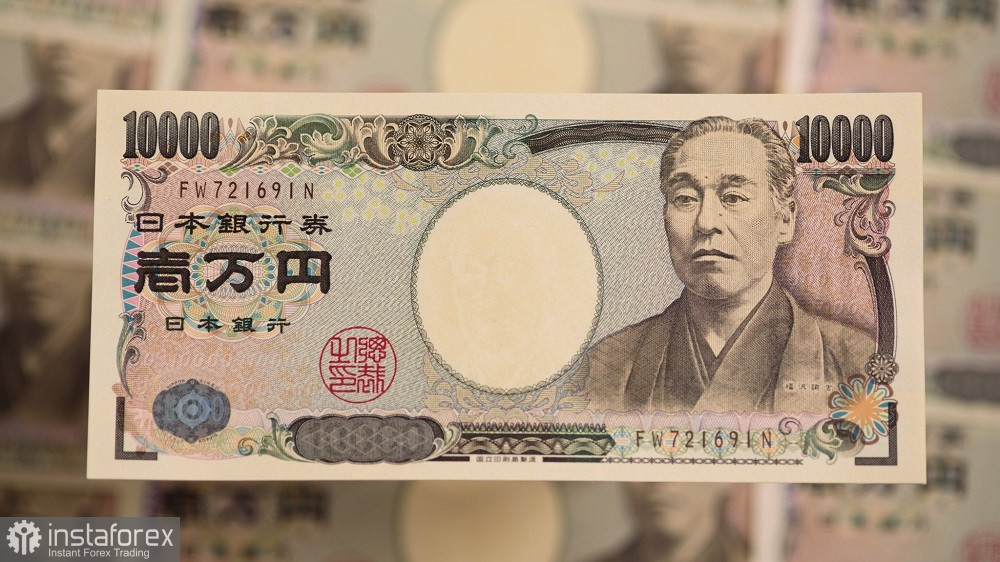The USD/JPY pair is slowly but steadily approaching the resistance level of 150.00, which corresponds to the upper Bollinger Bands line on the daily chart. The higher the pair climbs, the higher the risk of intervention from the Japanese government. Traders cannot ignore this factor as the pair approaches the infamous "red line."
It is important to recall events from a year ago. Throughout most of 2022, the yen actively lost ground against the backdrop of a strong US dollar. The USD/JPY pair consistently moved up with deep corrective pullbacks of 200-500 pips. Having started at the base of the 113th figure in January 2022, the price reached a 32-year high in October, marking 151.96.

It is worth noting that initially, the "red line" corresponded to the 146 level. For several weeks, USD/JPY buyers were hesitant to surpass this level, fearing the reaction of Japanese authorities. However, gradually, the pressure from dollar bulls increased amid rising inflation in the US, hawkish expectations regarding the Federal Reserve's future course of actions, and dovish rhetoric from Bank of Japan officials. USD/JPY buyers settled in the 147-149 range and then exceeded the psychologically significant resistance level of 150. After this, conducting a currency intervention became a matter of time.
Today, a similar situation is emerging. The pair is actively rising and if the yen breaches the 150 level, this could result in a verbal intervention from Tokyo. The price growth is facilitated by the rate discordance between the Japanese central bank and the Fed.
For instance, the BOJ, contrary to rumors of a departure from its current policy, has stated that all parameters of its monetary policy will remain unchanged in the foreseeable future. BOJ Governor Kazuo Ueda has hinted at a possible exit from negative interest rate policy—but only when the central bank believed that inflation would sustainably hold at the 2% level. However, inflation is still far from meeting this target. According to the latest data, the annual inflation rate in Japan increased to 3.2%, surpassing expectations of a decline to 3.0%. The core measure (excluding fresh food prices) remained at 3.1%, despite forecasts of a decrease to 3.0%. The National CPI (excluding fresh food and energy) came in at 4.3% compared to 4.3% in previous readings. The report indicates that in the near future (at least this year), the BOJ will not calibrate the parameters of its monetary policy.
On the other hand, the Fed maintains a hawkish stance, allowing for another interest rate hike by the end of this year. This is indicated by the updated "dot plot" released in September.
In other words, the current fundamental backdrop supports further price growth. However, the Japanese yen has a powerful card up its sleeve that could significantly change the situation for the currency pair. Soon (after likely surpassing the resistance level of 150.00), it will play the role of a sort of emergency brake. It is evident that we are talking about a currency intervention, the risk of which will increase along with the USD/JPY exchange rate. In this context, it can be said that the Japanese government controls the upper band of the price range within which the pair is traded. According to the majority of analysts, this is around the 150.00 mark, and exceeding this target comes with consequences.
Corresponding signals are already emerging even now, with the yen still within the 149.00 range. On Monday, Japan's Finance Minister Shunichi Suzuki, commenting on the yen's situation, stated that he is "carefully monitoring exchange rate movements." Similar verbal interventions were made last year in the run-up to a currency intervention. What's interesting is that USD/JPY traders ignored Suzuki's remarks: the pair continues to climb towards the 150.00 mark.
On one hand, you may still consider long positions on the pair, as the growth is supported by the current fundamental backdrop (primarily due to the rate discordance between the BOJ and the Fed). On the other hand, traders should be aware that a "risk zone" lies above the 150.00 level, where a sharp price reversal is possible in response to actions by the Japanese government. Take note that after reaching its price peak in 2022 (151.96), the pair reversed and lost over 2,000 pips in just a few months, ending the year at 131.12. The pair continued to fall into early 2023, down to the 127.00 level.
Therefore, at this moment, it is advisable to open long positions on bearish pullbacks with bullish targets of 150.00 and 150.50 (corresponding to the upper Bollinger Bands on the daily and weekly timeframes, respectively). Higher price levels come with greater risk.
 English
English 
 Русский
Русский Bahasa Indonesia
Bahasa Indonesia Bahasa Malay
Bahasa Malay ไทย
ไทย Español
Español Deutsch
Deutsch Български
Български Français
Français Tiếng Việt
Tiếng Việt 中文
中文 বাংলা
বাংলা हिन्दी
हिन्दी Čeština
Čeština Українська
Українська Română
Română

